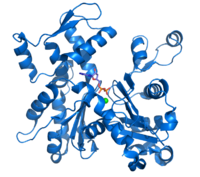
Photo from wikipedia
The poor prognosis of serous ovarian cancer (SOC) is due to its high invasive capacity and cisplatin resistance of SOC cells, whereas the molecular mechanisms remain poorly understood. In the… Click to show full abstract
The poor prognosis of serous ovarian cancer (SOC) is due to its high invasive capacity and cisplatin resistance of SOC cells, whereas the molecular mechanisms remain poorly understood. In the present study, the expression and function of non‐muscle myosin heavy chain IIB (MYH10) in SOC are identified by immunohistochemistry, in vitro, and in vivo studies, respectively. The mechanism of MYH10 is demonstrated by co‐immunoprecipitation, GST pull‐down, confocal laser assays, and so on. The results show that the knockdown of MYH10 suppressed SOC cell proliferation, migration, invasion, metastasis, and cisplatin resistance both in vivo and in vitro. Further studies confirm that the MYH10 protein functional domain combines with non‐muscle myosin heavy chain IIA (MYH9) to recruit the deubiquitinating enzyme Ubiquitin‐specific proteases 45 and deubiquitinates snail to inhibit snail degradation, eventually promoting tumorigenesis, progression, and cisplatin resistance in SOC. In clinical samples, MYH10 expression is significantly elevated in SOC samples compared to the paratumor samples. And the expression of MYH10 is positively correlated with MYH9 expression. MYH10+/MYH9+ co‐expression is an independent prognostic factor for predicting SOC patient survival. These findings uncover a key role of the MYH10‐MYH9‐snail axis in SOC carcinogenesis, progression, and cisplatin resistance, and provide potential novel therapeutic targets for SOC intervention.
Journal Title: Advanced Science
Year Published: 2023
Link to full text (if available)
Share on Social Media: Sign Up to like & get
recommendations!